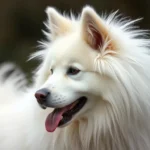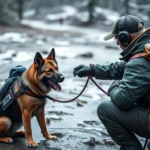
Introduction
Dog lunging at other dogs is a concerning behavior that can escalate into dangerous situations if not addressed. This behavior often manifests as a sudden, forceful movement towards another dog, which can be alarming for both the owner and the other dogs involved. Understanding and managing this behavior is essential for ensuring the safety of your dog, your family, and other pets.
Statistics indicate that a significant number of dog owners experience issues with aggression and lunging. According to the American Veterinary Medical Association, about 36% of dog owners report their dogs display aggressive behavior towards other dogs at some point. This highlights the importance of addressing lunging behavior early on to prevent it from becoming a habitual response.
This article aims to provide effective strategies and insights for managing and training a dog that lunges at other dogs, helping to create a safer and more enjoyable environment for everyone involved.
Understanding Dog Lunging Behavior
What is Dog Lunging?
Dog lunging refers to an impulsive, often aggressive movement towards another dog, typically accompanied by barking or growling. This behavior can occur on a leash, during walks, or in other situations where a dog encounters another canine. Lunging can stem from various triggers, including fear, excitement, or territorial instincts.
Causes of Lunging
Fear or Anxiety
Many dogs lunge out of fear or anxiety. When a dog feels threatened by another dog, it may instinctively react by lunging to protect itself. Signs of fear-based lunging can include cowering, tail tucking, or other anxious behaviors prior to the lunge.
Protective Instincts
Some dogs exhibit lunging behavior due to their protective instincts. This is particularly common in dogs that feel their owner or territory is being threatened. They may lunge to assert dominance or to ward off what they perceive as a threat.
Overexcitement
In contrast to fear, overexcitement can also trigger lunging. Dogs that are overly enthusiastic about greeting other dogs may lunge as a way of expressing their excitement. Often, these dogs have good intentions but need guidance to channel their energy positively.
Lack of Socialization
A lack of socialization during the critical early stages of development can lead to lunging behaviors. Dogs that haven’t been exposed to a variety of other dogs may not know how to behave appropriately in social situations, leading to anxious or aggressive responses.
Recognizing Warning Signs
Understanding your dog’s body language is crucial in recognizing when a lunge may be imminent. Common warning signs include:
- Stiffened body posture
- Raised hackles
- Intense staring at another dog
- Growling or barking
It’s important to be aware of situational triggers, such as crowded parks or unfamiliar environments, where your dog may feel more vulnerable or overstimulated.
Assessing Your Dog’s Behavior
Observational Techniques
To effectively manage your dog’s lunging behavior, begin with observational techniques. Spend time observing your dog in various settings to identify potential triggers. Keeping a behavior journal can be helpful in tracking patterns and noting specific situations that lead to lunging.
Professional Assessment
If your dog’s lunging behavior is severe or persistent, it may be beneficial to seek a professional assessment. A certified dog trainer or behaviorist can provide insights into your dog’s behavior and suggest tailored strategies for improvement. During an assessment, expect to discuss your dog’s history, triggers, and any previous training attempts.
Training Techniques to Manage Lunging
Basic Obedience Training
Establishing a foundation of basic obedience training is essential for managing lunging behavior. Commands like “sit,” “stay,” and “heel” can help you maintain control in distracting environments. Reinforcing these commands during walks, particularly around other dogs, can significantly reduce the likelihood of lunging.
Desensitization and Counter-Conditioning
Desensitization and counter-conditioning are effective methods for addressing lunging. This process involves gradually exposing your dog to their triggers at a distance where they feel comfortable. Over time, you can reduce this distance while rewarding calm behavior.
Here’s a step-by-step guide for implementing this technique:
- Identify a trigger (other dogs).
- Find an area where you can observe other dogs from a distance.
- Reward your dog with treats for remaining calm.
- Gradually decrease the distance to the trigger while continuing to reward calm behavior.
Leash Training
Proper leash training is crucial for managing lunging. Use techniques that promote effective leash handling, such as keeping the leash short but relaxed. Invest in the right equipment, like a no-pull harness, which can help prevent your dog from lunging forward unexpectedly.
Positive Reinforcement Strategies
Incorporating positive reinforcement strategies into training can yield significant results. Use treats and praise to reward good behavior when your dog remains calm around other dogs. Establishing a reward system for gradual improvements can motivate your dog and reinforce positive behavior.
Redirecting Attention
When you notice your dog beginning to lunge, redirecting their attention can be highly effective. Techniques to distract your dog include:
- Using a favorite toy or treat to regain focus.
- Practicing commands like “look at me” or “leave it” to divert their attention.
- Engaging in play or utilizing interactive toys during walks.
Socialization Techniques
Controlled Socialization
Controlled socialization is vital for helping your dog learn how to interact appropriately with other dogs. Gradual exposure to other dogs in a controlled environment can help your dog build confidence. Consider setting up playdates or meetings with calm, well-socialized dogs.
Group Training Classes
Participating in group training classes can also be beneficial. These classes provide a structured environment where your dog can learn to socialize with other dogs under the guidance of a trainer. When choosing a class, look for one that focuses on positive reinforcement and has a good reputation for managing behavioral issues.
Preventive Measures
Environmental Management
Implementing environmental management strategies can help minimize triggers in your dog’s daily life. Identify situations that lead to lunging and try to avoid them when possible. For instance, if your dog lunges at other dogs during walks, consider changing your route or walking during quieter times.
Ongoing Training and Reinforcement
Consistent training is key to managing lunging behavior long-term. Regular practice of commands and positive reinforcement will help maintain progress. Set realistic goals for your dog’s behavior, recognizing that improvement takes time and patience.
Common Mistakes to Avoid
While training your dog to manage lunging behavior, there are several common mistakes to avoid:
- Using punishment or negative reinforcement: This can exacerbate fear and anxiety, leading to more lunging.
- Ignoring warning signs: Failing to recognize your dog’s body language can result in missed opportunities for intervention.
- Inconsistent training: Inconsistency can confuse your dog and hinder progress.
By being aware of these pitfalls, you can create a more effective training strategy.
Conclusion
In summary, managing a dog that lunges at other dogs requires a multifaceted approach that combines understanding, observation, and training techniques. By addressing the underlying causes of lunging behavior and implementing effective training strategies, you can help your dog learn to respond appropriately in social situations.
Change is possible with time, patience, and dedication. Remember to celebrate small victories along the way, and don’t hesitate to seek professional help if needed. With commitment and the right techniques, you can create a happier, safer environment for both your dog and those around you.
FAQs
What should I do if my dog lunges at another dog?
If your dog lunges, try to remain calm and avoid pulling on the leash. Redirect their attention with treats or commands, and practice desensitization techniques.
How long will it take to train my dog not to lunge?
The timeline for training varies depending on the individual dog and the severity of the behavior. Consistency and patience are key, and you may see gradual improvements over weeks or months.
Can I train my dog myself, or do I need a professional?
Many owners successfully train their dogs with the right resources and commitment. However, if your dog’s lunging behavior is severe, seeking help from a professional trainer or behaviorist can provide you with tailored guidance.









